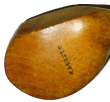Clubmakers
George Forrester, Elie and Earlsferry
(Source: © 1999 - 2013, Douglas MacKenzie)
Judged by the number of patents successfully applied for, George Forrester was one of Scotland's most innovative club makers, starting with the first concentric back, or centraject, club in 1890. These irons were centre-balanced with rounded backs gradually tapering from the top edge to the sole and from the heel to toe, were awarded patent number 12,524. The idea was to put as much weight as possible behind the sweet spot. He also produced the first real socket head wood, patented as number 269,117, the unbreakable drilled neck driver in 1898. These two patents revolutionised golf club design in their time. In addition to these two innovations he patented the ball back cleek in 1893, another attempt to put weight behind the sweet spot by using a protrusion, the double balanced approach mashie with two lumps behind the sweet spot in 1900. He also patented the bulldog bulger driver in 1892 and the bulbtoe cleek in 1895. Putters, too, attracted his inquiring mind with his '100' putter and the Acme both being awarded patents, the latter having a flanged top edge which projects over the bottom edge presenting a level surface to the eyes and ensuring a square connection with the ball.
His trailblazing technology was despite coming relatively late to clubmaking. He was originally a stonemason and had spent some time in the United States looking for work in this line before returning home to try his hand at clubmaking, at the age of 34, in 1871. His lack of reputation made his early days difficult and it was the 1890s before he became established as one of the masters. He was joined in business by his son, James, in 1903 and the firm was renamed George Forrester & Son. James opened a retail branch in London (the details of which you will sometimes come across marked on one of the firm's socket-head brassies) before returning to take over the running of the family business. He also became professional at the Golf House Club in Elie.
Many clubmakers came through his apprentice system, A H Scott, Tom Reekie, Jack Simpson, Ralph Smith and, according to Bernard Darwin, it was a chance event in Forrester’s workshop which led Ralph Smith to contribute indirectly to his best friend, James Braid’s, ability with a driver. One of Forrester’s customers, John Berwick, a very tall man at six foot four, called into the shop saying he had some clubs he wanted to dispose of and could they be collected. Smith immediately alerted his tall friend who came round to the shop and found a number of drivers with long shafts and flatter lies than his own. Trying one out, Braid found the ball flying in to the far distance. Buying it for one shilling and sixpence, giving Forrester a profit of sixpence, ‘James in a state of bliss straightaway outdrove all those who but lately had the audacity to outdrive him’.
The business came to a gentle end with the sale of golf clubs and clubmaker stock and machinery belonging to George Forrester, retired clubmaker, ‘attracting a large number of buyers from Dundee, Glasgow, St Andrews, Anstruther etc’ with ‘good prices realised throughout’ in March 1926. During his time in business he was also Provost (Mayor) of Earlsferry for three years.
He died in May 1930 at the age of 83.
|
|



Click on an image to view it in larger size
|
|
|

